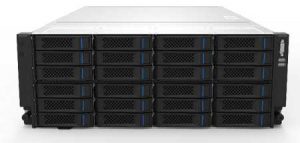Inspur AFA AS5000G5-F With Dual-Port Optane SSD
Up to 560,000 IO/s, 2.4GB/s bandwidth and 22μs read response time
This is a Press Release edited by StorageNewsletter.com on December 27, 2019 at 2:23 pmInspur Electronic Information Industry Co.,Ltd and Intel Corp. jointly launched its mid-range all-flash storage AS5000G5-F series with dual-port Optane SSD.
AS13000G5 SDS solution

The AS5000G5-F series offers up to 8 million IO/s and 0.1ms latency. Consisting of four models including AS5300G5-F, AS5500G5-F, AS5600G5-F and AS5800G5-F, the mid-range all-flash AS5000G5-F series drives performance improvements in software and hardware. In addition, the company also offers a SDS solution, AS13000G5, which supports single-port Optane SSD.
On the hardware side, the company’s mid-range all-flash storage AS5000G5-F adopts the second-gen Xeon Scalable processor and uses an dual-port Optane SSD as its cache layer. Offering a single-disk performance up to 560,000 IO/s or 2.4GB/s bandwidth and a read response time of 22μs, the Optane SSD can bridge the performance and capacity gap between memory and traditional storage media. Also, leveraging the medium advantage of 3D Xpoint, the dual-port Optane SSD provides a DWPD up to 30, which is 30-60 times the life of TLC 3D NAND SSD. At the same time, compared with SAS protocol, NVMe is a performance protocol designed for flash media, which is capable of running a large number of parallel IO operations.
On the software side, the AS5000G5-F series delivers improved performance and all-flash medium service by utilizing technologies such as InTier intelligent layering, real-time compression/re-delete, space recycle and intelligent medium life detection. Using intelligent layering as an example, data is divided into 4 tiers, i.e. boiling, hot, warm and cold. The data hot spot degree is precisely located through AI-based intelligent hot-spot identification, sequence flow identification and accurate cold data elimination algorithm. 3D Xpoint’s advantages are leveraged by facilitating intelligent data flow within different media such as Optane SSD, NAND SSD and high-capacity HDD to optimize performance based on data type. For example, the AS5000G5-F series would store metAdata: a typical type of boiling point data, on performance, low-latency Optane SSD to accelerate metadata access.
The AS5000G5-F series adopts a redundancy design that allows a single server to provide 99.9999% reliability and 5D expansion capability, and its heterogeneous virtualization technology inter-operates with over 95% of mainstream storage models from top 10 manufacturers in the industry. Meanwhile, the InView multi-device management platform and AIO/s active prediction technology enable a 14-day prediction accuracy of up to 95% and can reduce troubleshooting time by 70%.
Enterprises have a growing demand for real-time data. In 2019, real-time data accounts for 17.6% in the global data community, and a massive number of new real-time applications rely on the rapid collection, storage and analysis of such data.
“In the storage field, the fastest growing area is all-flash. That area is where opportunities and potential lie for technological innovations,” said Sun Bin, vice GM, storage product line, Inspur. “Storage vendors have to take advantage of new flash technologies to grasp this rapidly growing storage opportunity.“
“Intel is very happy to work with Inspur to apply Optane dual-port NVMe SSD into industry-leading high-performance all-flash storage products, to fully leverage the high performance, low latency and high reliability advantages of Optane,” said Liu Gang, GM, China’s non-volatile storage business unit, Intel.
The company will continue to work with partners like Intel to jointly promote the creation of storage solutions and drive the implementation of all-flash storage in industries such as finance, telecommunications and energy. Across industries, from real-time financial transactions and AI risk management, to intensive IO analysis in life sciences research and internet cloud databases, application demands are growing and the firm seeks to meet those demands while enhancing the ability of enterprises to gain insights from data.














 Subscribe to our free daily newsletter
Subscribe to our free daily newsletter

